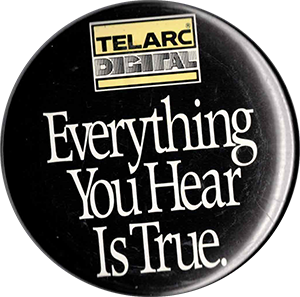Sidebar: The Classical Recording Session
The Grammy Awards were first awarded in 1958, and the engineering awards were part of that first year’s accolades, separated into Classical and Non-Classical.1 Historian Susan Schmidt Horning notes that it was around this time that “classical and rock recording now embodied ‘quite an opposite set of worlds and aesthetic requirements.”2 The first Producer of the Year award was given in 1975, with a separate Classical category starting in 1980, a distinction that continues to this day. The Recording Academy recognizes that the production of classical recordings is fundamentally different than in other genres, and the reasons are key to understanding the story of Telarc and its recordings.
Note that for this page, the term “studio” encompasses all the sorts of recording that typically happen in a studio setting, which includes Pop, Rock, Country, Hip Hop and many others. Click on the various headers below to read more about what is the same and what is different in these ways of recording.
Last updated on January 31st, 2025 at 06:26 pm
- The Recording Academy lists all the nominees and winners on their website. The first year’s laureates are here. ↩︎
- Classical producer Leroy Parkins, quoted in Susan Schmidt Horning, Chasing Sound : Technology, Culture, and the Art of Studio Recording from Edison to the LP (Baltimore: The Johns Hopkins University Press, 2013), 217 ↩︎
- For an in-depth look at the creation of popular music recordings, we recommend Rick Beato’s YouTube channel. Rick, an accomplished musician on several instruments, looks at hit songs from all sorts of interesting angles and goes into amazing detail on what makes them work. ↩︎
- Leo L. Beranek, Concert Halls and Opera Houses : Music, Acoustics, and Architecture, 2nd ed. (New York, NY: Springer, 2004), 2. ↩︎
- Noted in a tribute to Jack Renner. “For the Record,” Gramophone, September 2019, 8 ↩︎
- Quoted in Jason Victor Serinus, “Telarc Scores Big,” Stereophile.com, June 19, 2006 ↩︎
- R.E.M. discusses this type of creative chaos in an article about creating their album Green. ↩︎
- One great example is Luke Combs’ recent cover of Tracy Chapman’s “Fast Car”. They teamed up to perform a combination of their versions at the 2024 Grammy Awards. ↩︎
- Union recording contracts dictate that the engineers have just five minutes with the orchestra playing in order to make sure the sound is correct. After that, any time used for technical adjustments comes out of the forty minutes per hour that is intended for putting down takes. ↩︎
- Gramophone, June 1989, quoted in Donald Rosenberg, The Cleveland Orchestra Story : Second to None, 1st ed. (Cleveland: Gray & Company, 2000), 509. ↩︎
- This press release details some of the issues that were negotiated as part of the 2019 union agreement with the recording industry. ↩︎
- Glenn Gould and Tim Page, The Glenn Gould Reader, 1st ed. (New York: Knopf, 1984). 331-353 (originally published in the April 1966 issue of High Fidelity.) ↩︎
